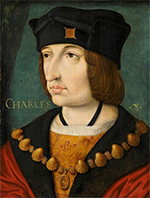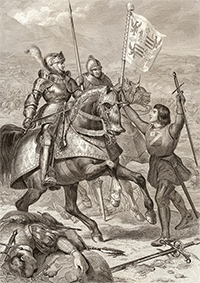The French King Charles VIII
Charles VIII was King of France in the late 15th Century. He is most well-known for invading Italy and claiming the kingship of Naples. 
He was born on June 30, 1470 in Amboise. His father was the reigning monarch, King Louis XI. Charles was a physically frail child and so didn't learn the arts of hunting and war. He became king when he was 13: His father died, on Aug. 30, 1483. Just a month earlier, he had been betrothed to Margaret of Austria, the 3-year-old daughter of the Archduke Maximilian. Because Charles was so young, his older sister, Anne, who was married to Peter of Bourbon, served as regent. One of her first acts was to call the Estates General, a gathering at Tours of members of the Three Estates: Clergy (First); Royalty and Nobility (Second); and Merchants, Traders, and Commoners (Third). Representatives gathered and hammered out a series of proposals during January–March. However, the young king left early and then announced that he had no money to pay for any reforms that the Estates General recommended. (Some of them found their way into royal policy under Charles's successor, Louis XII, who attended as a member of the Second Estate.) Charles was married in 1491 but not to his original betrothed. Instead, Charles married Anne of Brittany, in order to cement an alliance between France and Brittany. Margaret of Austria returned home, along with her dowry. In that same year, Charles became king in his own right. Right away, he set about making alliances. He inked the Treaty of Barcelona with Maximilian I of Austria and the Treaty of Étaples with England. His northern borders free from invasion threats, Charles turned to Italy, where he got involved heavily in As surprising and awe-inspiring as the long march and number of victories were, they amounted to a hollow victory for Charles and France because they produced the League of Venice, a consortium of Italian duchies, republics, and kingdoms that all lined up to oppose the French occupation force. In a few short months, armies from Florence, Mantua, Milan, and Venice joined hands with a Spanish army and endeavored to trap Charles in southern Italy. The League defeated the French at the Battle of Fornovo, in July 1495. However, League losses doubled French losses, and Charles's force was still strong enough to punch its way back up the western coast, returning to France and leaving behind a handful of lightly defended garrisons. Italian and Spanish armies made quick work of the garrisons, and Charles had nothing show for his daring success except bragging rights. The king, once home, began planning another invasion. Saddled with the debt from the first one, however, he didn't get very far. Charles died in 1498, in a freak accident. His predecessor Louis IX had popularized the game of jeu de paume (real tennis), and Charles was a fan. He set out on April 7 to watch a game in Amboise and knocked his head heavily while going through a doorway. He attended the game and then, after returning to the royal residence, fell into a coma from which he never awoke. He and his wife had seven children, all of whom predeceased them. Next on the French throne was Louis, Duke of Orléans, who was the second cousin of Louis XI. He ruled as King Louis XII. |
|
Social Studies for Kids
copyright 2002–2025
David White



 the struggles that had punctuated the growth of various Italian cities and municipalities for centuries. Charles, at the head of a 25,000-man-strong army, marched into Italy and seized wide swathes of territory, from Milan and Florence in the north to Naples in the south. Charles had himself crowned King of Naples in early 1495.
the struggles that had punctuated the growth of various Italian cities and municipalities for centuries. Charles, at the head of a 25,000-man-strong army, marched into Italy and seized wide swathes of territory, from Milan and Florence in the north to Naples in the south. Charles had himself crowned King of Naples in early 1495.
